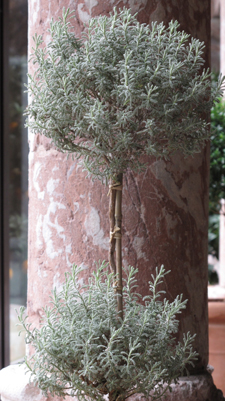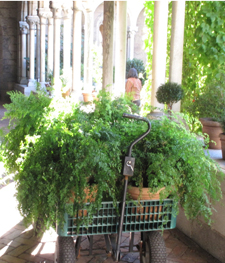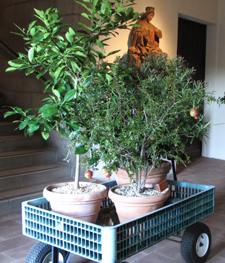Friday, February 24, 2012


The ‘evergray’ santolina is cold hardy in our climate, but dislikes our wet winters. We prefer to grow this aromatic herb in pots and bring it indoors in autumn. Above, left: Santolina is also known as cotton lavender, because of its dense, whitish-gray foliage and strong fragrance; Right: A santolina topiary made from a dwarf form of the species.
A compact, woody plant of dry ground and stony banks, the Mediterranean santolina (Santolina chamaecyparissus) is cold hardy in our USDA Zone 7 gardens, but dislikes wintering over in wet soil; we prefer to grow it in pots and bring it indoors in autumn. Santolina’s slender stems are densely covered with short, thick, cottony leaves. This low-growing evergray species lends itself to shaping and shearing, and was widely used as an ornamental edging plant in Renaissance knot gardens. It’s also an excellent subject for topiary work, especially the dwarf form of the species, S. chamaecyparissus ‘Nana.’
Read more »
Tags: Andres de Laguna, artemisia, cherry, cornelian, Cornus europaea, cornus mas, De Materia Medica, Dioscorides, evergray, santolina, Santolina chamaecyparissus, southernwood, topiary, wormwood
Posted in Botany for Gardeners, Gardening at The Cloisters | Comments (2)
Friday, October 28, 2011


Potted plants too tender to spend the winter in Bonnefont garden are trucked inside and brought up to Cuxa cloister, which is??glazed in mid-October. Mediterranean plants such as bitter orange, myrtle, and bay laurel spend the cold season in the sunny arcades and??are brought back out to the herb garden when the glass comes down in mid-April. Left:??A wagonload of maidenhair fern in the arcade of Bonnefont garden. Right:??oranges and pomegranates en route to Cuxa cloister.?? Photographs by Carly Still
While the medieval plant collection at The Cloisters includes a good number of northern European species, a great many of the plants grown in the Bonnefont Cloister herb garden are Mediterranean in origin. Not all of these southern European plants are hardy for us here in New York City. The garden is a sheltered U.S.D.A. Hardiness Zone 7, and the fig tree (Ficus carica), poet’s jasmine (Jasminum officinale), and lavender (Lavandula angustifolia) do just fine outdoors, but more tender species like bitter orange (Citrus aurantium), rosemary (Rosmarinus officinalis), bay laurel (Laurus nobilis), and dittany of Crete (Origanum dictamnus) must be brought inside and protected from the cold. Read more »
Tags: Albertus Magnus, bay, Citrus aurantium, cucumber, cucurbit, dittany, fern, ficus carica, fig, jasmine, Jasminum officinale, laurel, Laurus nobilis, Lavandula angustifolia, Lavender, maidenhair, myrtle, orange, Origanum dictamnus, rosemary, Rosmarinus officinalis, santolina, winter
Posted in Food and Beverage Plants, Fragrant Plants, Gardening at The Cloisters, Introduction, Magical Plants, Medicinal Plants, Medieval Agriculture, Plants in Medieval Art | Comments (2)




